

Starburst Polyp. Overview The Starburst Polyps are also referred to as Star, Eight Tentacle, Mat, or Daisy Polyps.

They are usually white or brown with a white dot in the center of each polyp, although, some more rare Starburst Polyps are green. The green specimens have been called Clavularia viridis; however, they are now identified as a Briareium sp. They have the distinctive eight-leaved tentacles on each polyp. They are colonial animals with several individual polyps attached to a piece of live rock. Finger Leather Coral. Overview The Mushroom Finger Leather Coral is referred to as Sinularia Coral, Finger Leather, or Trough Corals.
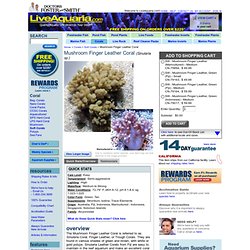
They are found in various shades of green and brown, with white or gold polyps. Sinularia Leather Corals from Fiji are easy to maintain in the reef aquarium and make an excellent coral for the beginning through expert reef aquarist. Mushroom Finger Leather Corals are relatively peaceful, but adequate space should be provided between them and other corals in the reef aquarium.
Some can produce toxins which are harmful to other reef inhabitants. Mushroom Finger Leather Corals require high lighting combined with medium to strong water movement. Yellow Fiji Leather Coral. Overview The Yellow Fiji Leather Coral may be referred to as the Sarcophyton elegans Coral.
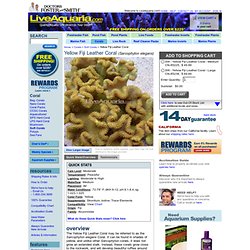
Yellow Leather Coral, Sarcophyton elegans, Soft Coral Information, Elegant Leather Coral Care and Coral Pictures. When the Yellow Leather Coral is happy its tentacles come out, giving it a fuzzy look!
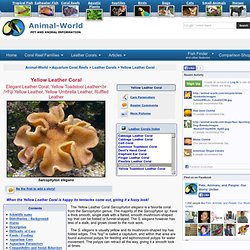
The Yellow Leather Coral Sarcophyton elegans is a favorite coral from the Sarcophyton genus. The majority of the Sarcophyton sp. have a thick smooth, single stalk with a flared, smooth mushroom-shaped top that can be folded or funnel-shaped. The S. elegans however has less of a stalk, and grows closer to the rock work. The S. elegans is usually yellow and its mushroom-shaped top has folded edges.
This "top" is called a capitulum, and within that area are found autozooid polyps for feeding and siphonozooid polyps for water movement. It is a very attractive mushroom in the reef aquarium, but unlike the other leathers the S. elegans is sensitive to many occurrences in the captive environment. Brain Coral, Trachyphyllia. Devil's Hand Leather Coral. Overview The Devil's Hand Leather Coral is also referred to as Finger Leather Coral, Cabbage Leather Coral, or Lobed Leather Coral.
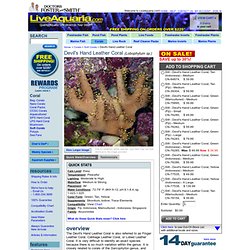
It is very difficult to identify an exact species because there is so much variation within the genus. It is closely related to corals of the Sarcophyton genus, and especially with small colonies, it is almost impossible to differentiate between the two. Assorted Colored Mushroom. Green Toadstool Mushroom Leather Coral. Overview The Toadstool Mushroom Leather Coral is referred to as Sarcophyton Coral, Mushroom, Leather, or Trough Corals.
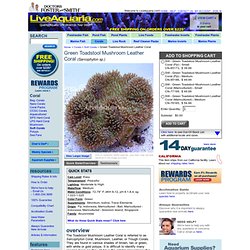
They are found in various shades of brown, tan or green, with white or gold polyps. It is difficult to identify many species because they all have the similar appearance of a mushroom or toadstool, each with a distinct stalk and capitulum (cap). As they grow older, they develop a folded appearance. The Toadstool Mushroom Leather Corals are relatively peaceful, but adequate space should be provided between them and other corals in the reef aquarium. Culturing by the experienced hobbyist is often accomplished by cutting off a portion of the Coral's crown and attaching that piece to live rock or placing it in the sandy bottom of the reef aquarium.
Hairy Mushroom. Overview The Rhodactis Hairy Mushroom is a member of the order Corallimorpharia and occurs in many colors including brown and tan, and the more colorful green.
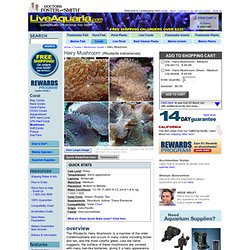
Like the name suggests, the surface of these mushrooms are covered with many hair-like tentacles, giving it a hairy appearance. It is very easy to maintain in the reef aquarium, and a good choice for the beginner hobbyist. It is somewhat aggressive, however, and can harm sessile invertebrates and overgrow other inhabitants of the reef. It often grows in shallow water, so it prefers a medium to high light level combined with a medium water movement within the aquarium. It reproduces by fission or laceration, and will do so in the home aquarium provided that water conditions are adequate, sometimes causing over-population. The symbiotic algae zooxanthellae hosted within its body provide some of its nutritional requirements, but it also eats plankton and some larger organisms. Mushroom Corals : Aquatic Connection Live.
So What do you get?
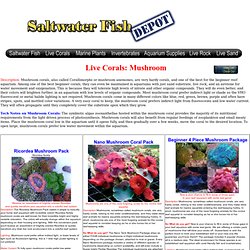
Now is your chance to fill in some of those gaps in your reef aquarium with some real gems. We are offering a combo pack of mushrooms that will blow your socks off. Guaranteed to add the perfect touch to both your established reef or your new one.We guarantee you'll love them!!! The package includes 4 popular choices, all in a medium size. The ideal environment for these species is an established reef aquarium with coral friendly fish and invertebrates. Bubble Coral. Overview The Bubble Coral is a beautiful LPS coral that originates from the reefs of the Indo-Pacific.

It has a green or white-ridged hard skeleton that can be seen when the polyps are deflated. When inflated, the large fleshy polyps will cover the entire skeleton, and are green, white or yellowish in color. Like many other LPS corals, they do posses sweeper tentacles that can harm other corals within reach. The Bubble Coral requires a moderate level of lighting combined with low to moderate water movement in the aquarium. It will benefit from additional food fed weekly in the form of brine shrimp or micro-plankton. Approximate Purchase Size: Small: 2" to 3"; Medium: 3" to 4"; Large: 4" to 6"; X Large: 6" to 8";
Plate Coral, Short Tentacle. Overview The Short Tentacle Plate Coral is a large polyp stony (LPS) coral often referred to as a Disk, Mushroom, Chinaman, Fungia Plate, or Tongue Coral.
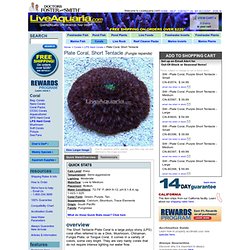
It comes in a variety of colors, some very bright. They are very hardy corals that do not require intense lighting nor water flow. It is a solitary, semi-aggressive coral with shorter tentacles than its cousin the Long Tentacle Plate Coral (Heliofungia sp.). Even with short tentacles, it can still damage other corals that it comes in contact with. It is ideal to feed Plate Corals a few times per week with brine or mysis shrimp, and small chopped meaty foods. Approximate Purchase Size: Small: 2" to 3"; Medium: 3" to 5"; Large: 5" to 7"
Trumpet Coral. Overview The Trumpet Coral is a large polyp stony (LPS) coral often referred to as the Trumpet, Torch, Candy, or Bullseye Coral. The skeleton of this species is branched out of a central base, and terminates into a large head that resembles a trumpet. Hammer / Anchor Coral, Branching. Overview The Hammer Coral, Branching is a large polyp stony (LPS) coral and often referred to as Euphyllia Hammer Coral or Anchor Coral.
Its common names are derived from the appearance of its hammer-, or anchor-shaped tentacles. Its polyps are visible throughout the day and night and hide its skeletal base. It may be green, tan, or brown in color, with lime green or yellow tips on the ends of its tentacles that glow under actinic lighting. Some varieties may be branched which makes them look similar to a Torch Coral (E. glabrescens). It is moderately difficult to maintain, but with proper water conditions in the aquarium, it will thrive. It will benefit from additional food fed weekly in the form of micro-plankton or brine shrimp. Approximate Purchase Size: Small: 2" to 3"; Medium: 3" to 5"; Large: 5" to 7"; Aquacultured: 1" - 2"
Hammer / Anchor Coral. Overview The Hammer Coral is a large polyp stony (LPS) coral and often referred to as Euphyllia Hammer Coral or Anchor Coral. Its common names are derived from the appearance of its hammer-, or anchor-shaped tentacles. Its polyps are visible throughout the day and night and hide its skeletal base. Sun Coral, Yellow, Tubastrea sp.
Overview Daisy-bright beauty, gently swaying polyps, unique feeding habits and low light requirements make the Tubastrea Yellow Tube Coral a perfect LPS coral for the deepest zones of your reef aquarium. Blueberry Sea Fan. Overview The Blueberry Sea Fan is also referred to as the Blue Gorgonia or Blue Tree coral. Blue is a very unusual coloration for any coral, and this Sea Fan will make a great showpiece or centerpiece to any reef aquarium. The red or orange base color with intense blue polyps differentiates this variety from other sea fans. The Blueberry Sea Fan is a peaceful, but it should be given adequate space away from neighboring corals or anemones. Underwater epoxy is commonly used to anchor its base to a piece of live rock in the reef aquarium. Live Sea Fans and Gorgonians: Sea Rods, Feather Gorgonians, Finger Gorgonians, Ribbon Gorgonians, Sea Fans.
Sea fans are found primarily in shallow waters, though some have been found at depths of several thousand feet. The size, shape, and appearance of the gorgonians are highly correlated with their location. The more fan-shaped and flexible gorgonians tend to populate shallower areas with strong currents, while the taller, thinner, and stiffer gorgonians can be found in deeper, calmer waters. Anatomy Gorgonians consist of individual tiny polyps that form colonies. Zoanthids: Live Salt Water Zoanthids and Palythoa Coral For Sale. Description:This species is a soft coral but with a hard skeleton of calcium carbonate that contains many organ pipe-like tubes.
On each tube is a series of polyps which each have eight feather-like tentacles. These tentacles are usually extended during the day, but will swiftly retreat with any sort of disturbance. Coral Polyps: Colonial Coral and Button Polyp Corals. Sea Mats. LPS Corals for your Saltwater Reef Aquarium - Aquatic Connection. Description: Fancy Doughnut Corals, are the top picks in the industry and are very difficult to get a hold of. When they are found they are put aside and sold as Ultra Fancy Doughnut Corals.
Customers who purchase these beauties when available are recieving one of a kind show pieces for their reef tank. The Scolymia sp. Torch Coral. Overview.